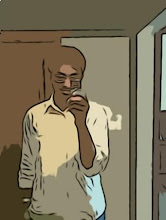Friday, October 3, 2008
Here is another illusion. I have seen it presented as a puzzle or math problem but commonsense tells us that this must be an illusion. The only thing we have to do is try and explain the illusion.

Solution:
The area of a right triangle is computed by multiplying the base times the height and dividing by two. The pieces of the puzzle have an area of 32 square units. Although they can be assembled to form what appears to be a 13×5 right triangle, they actually form quadrilaterals that are slightly smaller or slightly bigger than a 13×5 right triangle.
The top figure has an area of 32 square units. The bottom figure, including the empty square, has an area of 33 square units. A real 13×5 right triangle would have an area of 32.5 square units. The distortion is difficult to see because one square of the picture is approximately 3% of the area.
The distortion can be seen more clearly when the empty square constitutes a larger percentage of the area, as in the figure below where 1 square represents 13% of the area.


Solution:
The area of a right triangle is computed by multiplying the base times the height and dividing by two. The pieces of the puzzle have an area of 32 square units. Although they can be assembled to form what appears to be a 13×5 right triangle, they actually form quadrilaterals that are slightly smaller or slightly bigger than a 13×5 right triangle.
The top figure has an area of 32 square units. The bottom figure, including the empty square, has an area of 33 square units. A real 13×5 right triangle would have an area of 32.5 square units. The distortion is difficult to see because one square of the picture is approximately 3% of the area.
The distortion can be seen more clearly when the empty square constitutes a larger percentage of the area, as in the figure below where 1 square represents 13% of the area.

Labels: Optical Illusions
Subscribe to:
Post Comments (Atom)


0 comments:
Post a Comment